Explore Inside the Old North Church in Boston
Enjoy this behind-the-scenes tour of the Old North Church, Boston’s oldest surviving church building, including a bonus look at the church’s bell-ringing chamber and underground tombs.
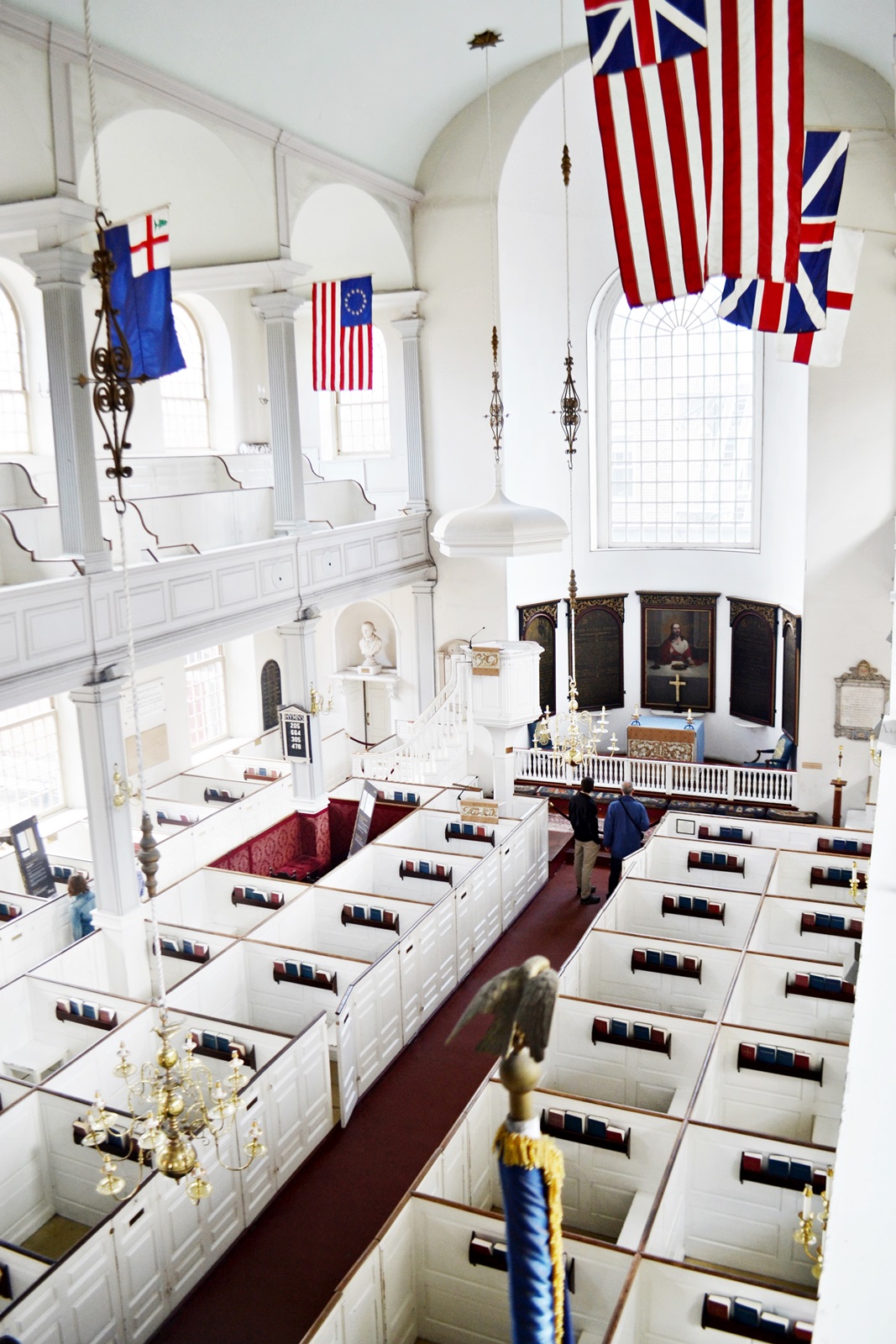
Coffee By Design | Portland, Maine
Photo Credit : Katherine KeenanIt’s tough to pick a favorite thing about Boston’s North End neighborhood, that bustling hub of Italian bakeries, pizzerias, and cafes just steps from Quincy Market and Faneuil Hall, but if you follow the red-brick Freedom Trail through its narrow streets, you’ll soon come to my favorite – the Old North Church.
Founded in 1722, the Old North Church, officially known as Christ Church in the City of Boston, is Boston’s oldest surviving church building and one of its most popular historic sites.
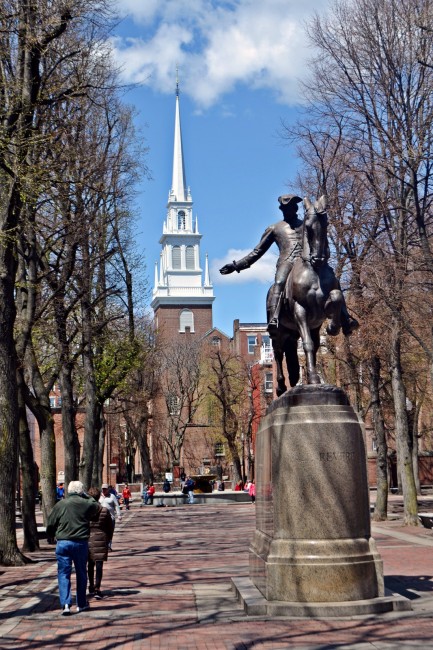
Photo Credit : Aimee Seavey
It is most famous for the role it played in the American Revolution on the evening of April 18, 1775. That night, church sexton Robert Newman and vestryman Capt. John Pulling, Jr. climbed the steeple and lit two lanterns to signal that the British were marching to Lexington and Concord by sea (across the Charles River), rather than by land. This served as the spark to Paul Revere’s famous midnight ride (which we all know is more legend than fact, but let’s save that for another post), and the start of the American Revolution.
We think of the Old North as one of the beacons of colonial patriotism, but actually, in 1775, the majority of the congregation was loyal to the British crown, making its eventual role in the start of the war even more extraordinary.
There’s a reasonable admission fee to tour the church, but you can also add on a behind-the-scenes tour.
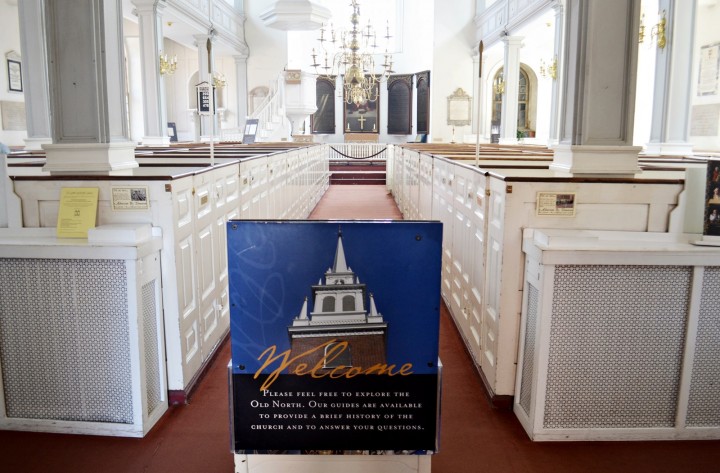
Photo Credit : Aimee Seavey
Inside, especially on a nice day with the sun streaming in through the windows, the church is a history-lover’s dream. Wooden, creaky, and just worn enough – the church is a true American treasure.
Upstairs, I was lucky enough to get a better view.
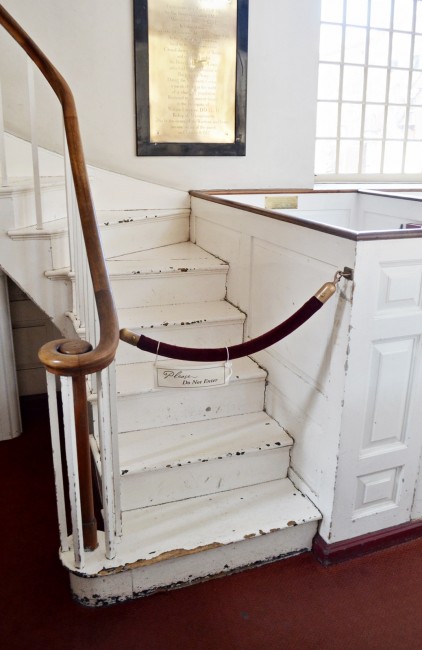
Photo Credit : Aimee Seavey
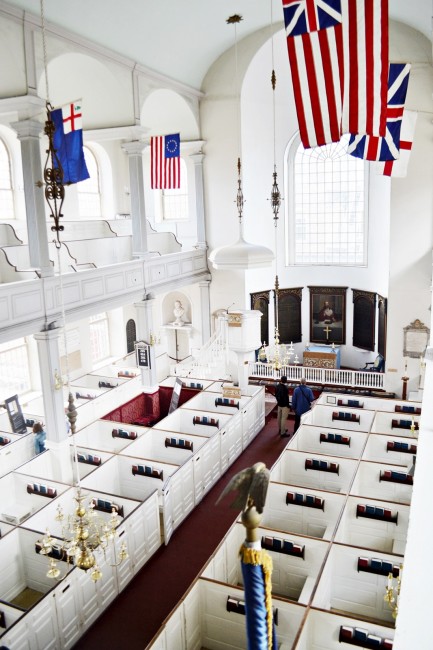
Photo Credit : Aimee Seavey
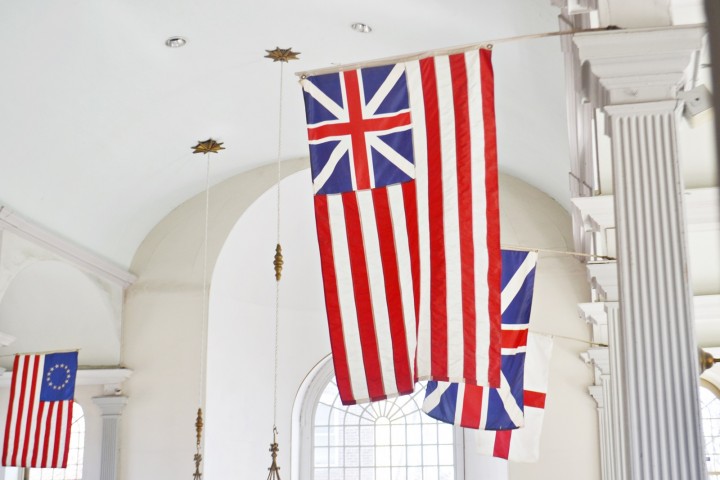
Photo Credit : Aimee Seavey
And there’s nothing like a little colonial graffiti to get your history-loving heart pumping.
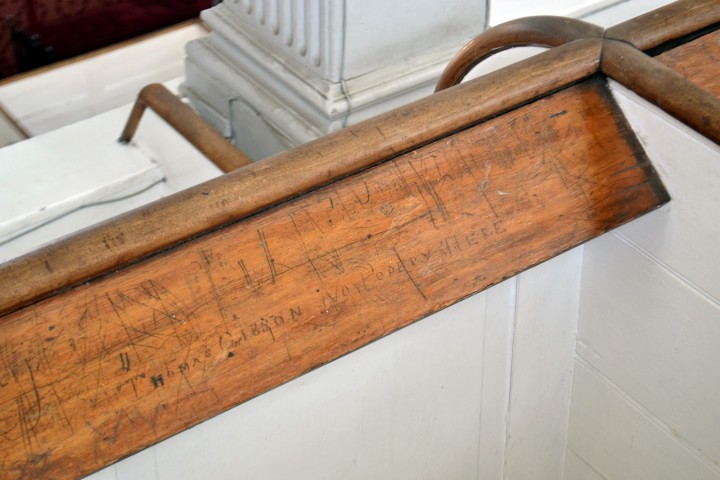
Photo Credit : Aimee Seavey
After ducking into the gift shop next door to the church and buying a ticket for the afternoon tour, I was met by my guide, Louis. He told me I was the only one that had signed up. In my experience, this usually leads to the best tours, and the Old North Church was no exception.
First, we climbed a small (but steep) flight of stairs to a room set up with some period photos to help tell the story of the church’s history. For example, the original steeple was destroyed by the Storm of October 1804. The replacement, designed by famed architect Charles Bulfinch, was also toppled, this time by Hurricane Carol on August 31, 1954 (see the photo below). The current steeple borrowed design elements from both, and (fingers crossed) will stand proud for decades, if not centuries, to come.

Photo Credit : Aimee Seavey

Photo Credit : Aimee Seavey
Then, it was up the narrow wooden staircase to the bell ringing chamber.
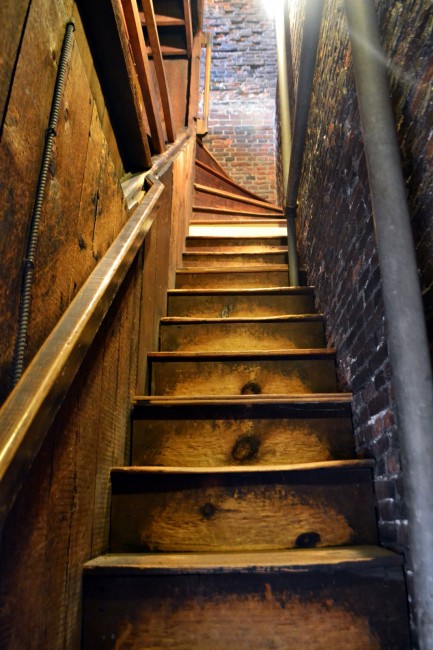
Photo Credit : Aimee Seavey
On the way up, I noticed a familiar pair of lanterns nestled together in a window. This pair are identical to the ones believed to have been hung in the steeple in 1775. If you’d like to learn more about the alleged surviving Revere Lantern, you can do so here.
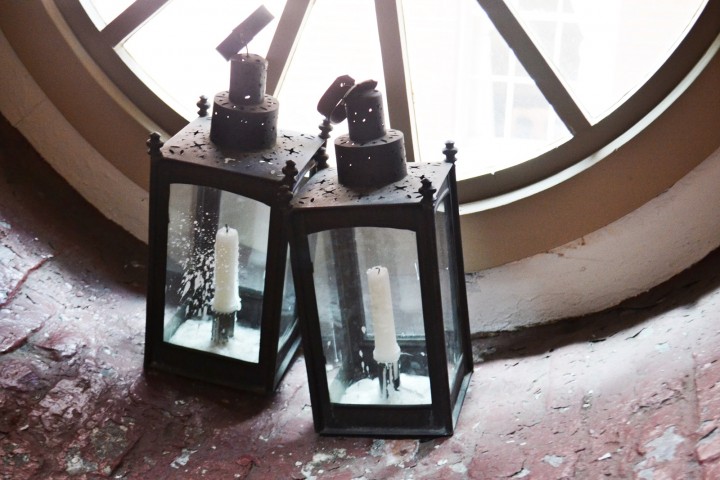
Photo Credit : Aimee Seavey
We went through the door, which was aged to perfection and covered in bell ringing patterns, and into a room criss-crossed with heavy ropes.
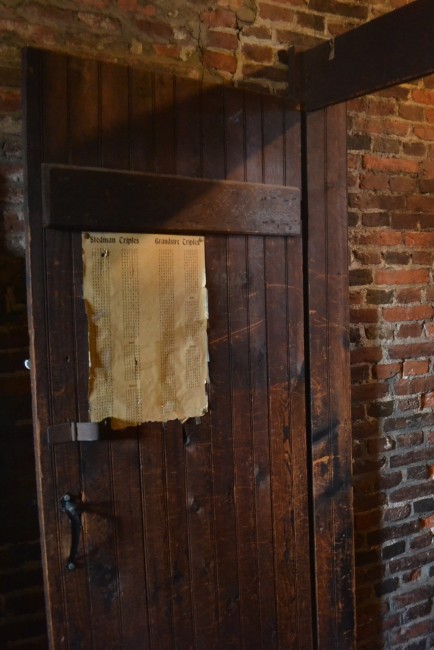
Photo Credit : Aimee Seavey
There are eight original change ringing bells (meaning the bells are rung in a series of mathematical patterns called “changes”) at the Old North Church, tucked up into the steeple. The oldest bells in North America, they were cast in Gloucester, England in 1744 and hung in Boston in 1745. One bell has the inscription: “We are the first ring of bells cast for the British Empire in North America, A.R. 1744.”
In the bell ringing chamber, a small but passionate group of trained ringers from the Massachusetts Institute of Technology Guild of Bellringers man the bells, and it’s charming to see evidence of their normal, modern lives (coffee cups, group photographs, a map with pins stuck into it) in the midst of so much history.
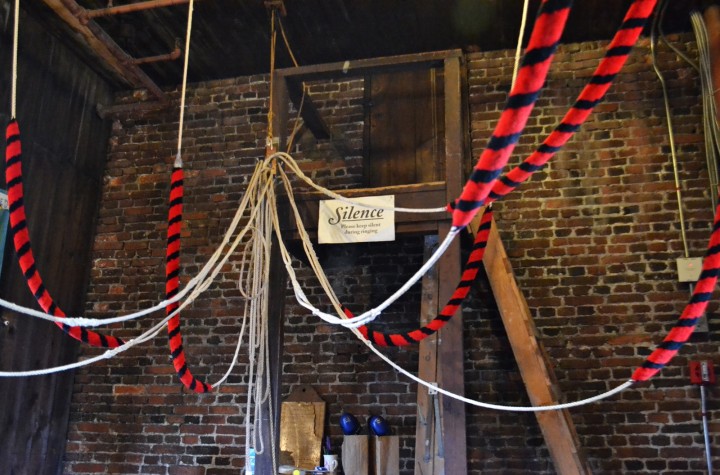
Photo Credit : Aimee Seavey
Louis told me that Paul Revere had grown up in the neighborhood (you can visit his adult house just a quarter-mile away), and had been a bell ringer himself. His signature can be found on the original 1750 Bell Ringer’s Agreement, in which the guild agreed upon a democratic organization of the tower.
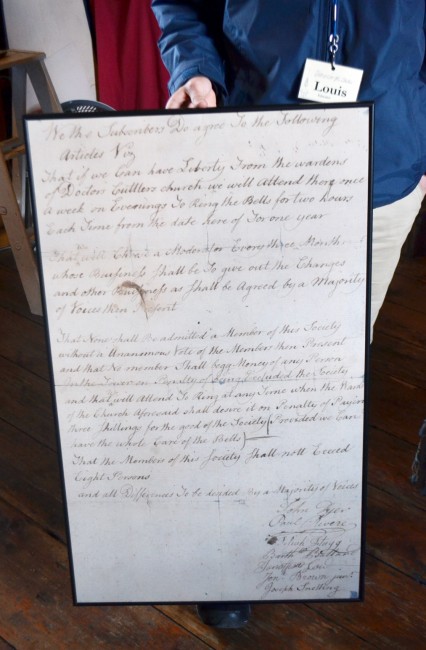
Photo Credit : Aimee Seavey
Remember how I said that sometimes when you’re the only one that signs up for a tour, you get an even better one? Here’s where my tour of the Old North Church went from good to great – I got to see the actual bells myself! They’re up yet another steep set of stairs (more like a ladder, actually), exactly where they have been for 270 years, connected to the ropes below. Hello, beautiful bells!
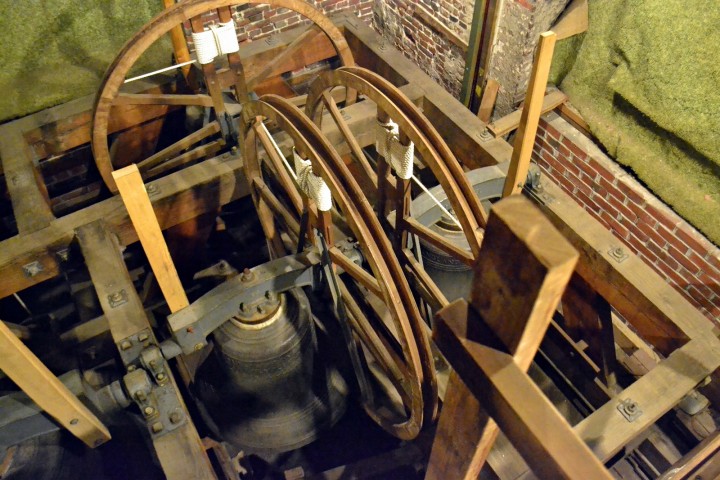
Photo Credit : Aimee Seavey
After slowly descending back to ground level, it was time to head outside and to the back of the church for the “underground” part of the tour in the church’s crypt. There are 37 tombs (with an estimated 1,100 bodies) underneath the Old North, constructed between 1732 and 1860. Only in recent years has more been learned about them… and the bodies inside.
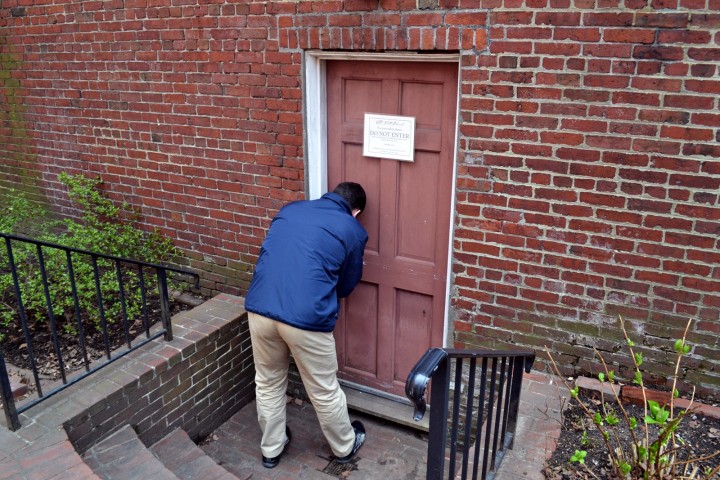
Photo Credit : Aimee Seavey
Again, this part of the tour is very authentic. Louis told me more than once to watch my step or duck under a pipe. The space hasn’t been extensively modified or remodeled for visitors, which gives it a wonderful “old” look and feel, if you’re into that sort of thing… which I definitely am.
After being filled, each tomb was sealed with a wooden or slate door, with many doors covered over by plaster per city order in the 1850s. Here’s one door that’s only partially covered today.
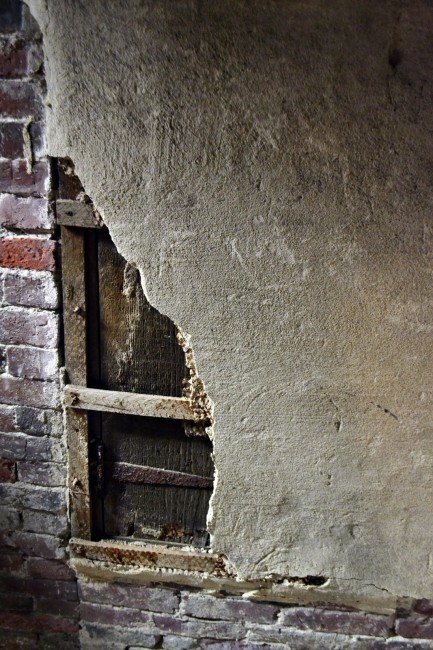
Photo Credit : Aimee Seavey
The “Stranger’s Tomb” from 1813 was used to bury poorer citizens, including children, that had died from disease.
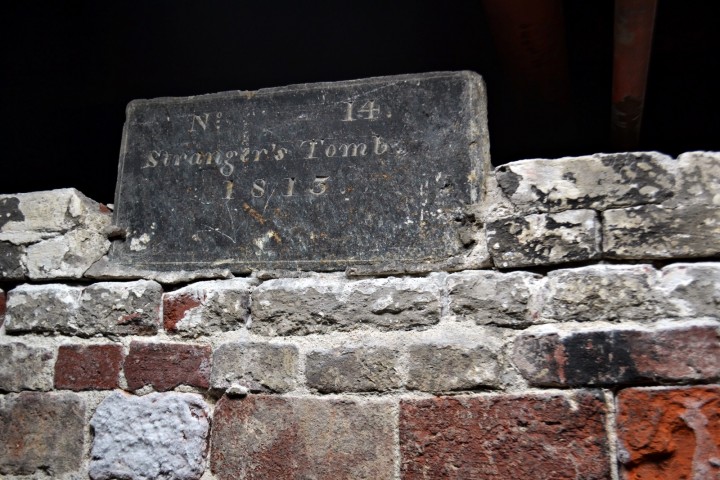
Photo Credit : Aimee Seavey
And beyond a hulking mass of (cheery red) water pipes…
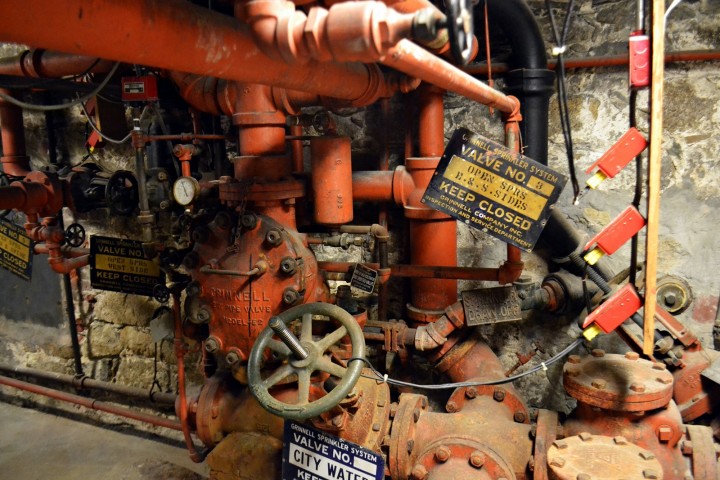
Photo Credit : Aimee Seavey
You’ll find the tomb of John Pitcairn, a British Marine officer stationed in Boston at the start of the Revolutionary War. Unlike many British officers, Pitcairn was respected, and maybe even liked by Bostonians. He died shortly after being shot at the Battle of Bunker Hill in June 17, 1775, and was buried here at the church, as were many others that fell that day.
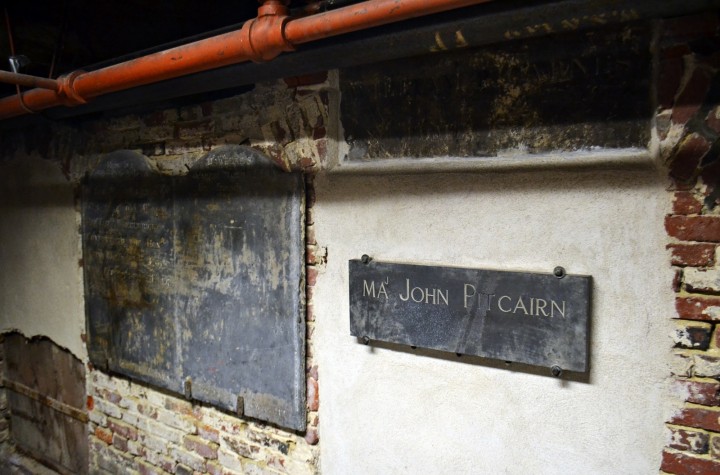
Photo Credit : Aimee Seavey
The crypt is also the final resting spot of Captain Samuel Nicholson of the USS Constitution (the famous “Old Ironsides” from the war of 1812). Louis told me that servicemen still visit his tomb today to pay their respects. It’s an amazing peek into another side of 18th and 19th century Boston.
Each year, half a million visitors visit the Old North Church, and I suspect that most of them wander over to Modern or Mike’s Pastry afterward for a cannoli, or Pizzeria Regina or Galleria Umberto for a slice (and if not, they should). History and good food in one of the greatest American cities – what more could you ask for?
Have you ever been to Boston’s North End and visited the Old North Church?
LEARN MORE: Visiting the Old North and have a sweet tooth? Don’t miss Captain Jackson’s Historic Chocolate Shop just next door. See more from our visit: The History of Chocolate in New England.
The Old North Church. 193 Salem Street, Boston. 617-523-6676; oldnorth.com
This post was first published in 2015 and has been updated.






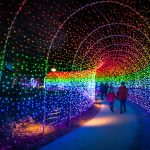

I will Go Next time there ! Mapquest cannot get the streets right there!
That was a fascinating story to read. I learned a lot of interesting historical information about this beautiful church. Hope I am the only person signed up for whatever my next tour may be….,
Great pictures! They really capture this unique and very historic treasure tucked into Boston’s North End.
Adding Old North to my must see list.
Thank you for this excellent, appreciated, educational insight!
I am now a transplant from the east coast to the west coast….it is so refreshing to read about the places I have been…keeps my memories alive….thank you Yankee for your enlightening articles….I Love New England…
Thank God for YANKEE magazine! I look forward to the magazine each month, especially when there is an article about my beloved Boston (!) and of course, all articles about New England but especially Mass. Thank You!
A wonderful story…I will always be a be a New Englander..wish I still lived there…Have seen all the wonderful historical areas but never “behind the scenes” facinating. …
Before I met my late husband, who served in the Navy and Navy Reserve for a total of 8 years, who trained on Old Ironsides, which is where he was taught his knots, necessary training for his position, I lived around the corner from Old North Church at 25 Charter St., and my best friend lived on Snelling Place, an alley just off Hull St., right near the church, where I visited her many times during the many years she lived there. I had a friend, not her, visiting during a very cold week in February and she wanted to visit the church, which I had visited many times, so, we, too, got a private, FREE tour and were asked to sign the guest book when we were invited into the bell tower, which we were told was an honor and a privilege. I FOUND YOUR ARTICLE VERY INFORMATIVE BECAUSE I DID NOT KNOW ABOUT THE CRYPT OR THE CANDY STORE! Do you know about the Saturday Evening Girls, local domestics (maids), I believe mostly from Ireland, who were taught pottery making and decorating and their wares were sold in the gift shop? I believe this began in 1914. I have a few plates made by “these girls”, it is known as Saturday Evening Girls pottery and is very rare, collectible and desirable to those who know about it. Thank you for teaching me something new about one of my favorite place. I ALSO SPENT A LOT OF TIME EXPLORING COPPS HILL BURYING GROUND, WHICH HAS A TUNNEL TO THE BASEMENT OF THE CHURCH, MY FRIENDS’ LANDLORD ON SNELLING PLACE HAS THE TUNNEL GOING THROUGH HIS PROPERTY, AND WAS FEATURED ON CHRONICLE SHOWING IT, WHICH HE BRICKED IN BECAUSE HIS YOUNG CHILDREN PLAYED DOWN THERE. I HAVE VISITED EVERY GRAVE IN THAT CEMETERY, WHERE WILLIAM DAWES IN BURIED. MY HUSBAND WAS A MASTER MASON AND MY FATHER WENT FURTHER IN THAT ORGANIZATION, SO I WAS INTERESTED TO LEARN THAT MANY OF THEM WERE MASONS, AS INDICATED ON THEIR GRAVE STONES. PAUL REVERE AND WILLIAM DAWES WERE ALL MASONS, BELONGING TO COLUMBIA LODGE IN BOSTON, WHERE PAUL REVERE WAS A MASTER OF THE LODGE. BENJAMIN FRANKLIN AND THE ADAMS PRESIDENTIAL FAMILY LOCAL RESIDENTS, FROM QUINCY, MA, WERE ALSO MEMBERS OF THAT LODGE. THE LODGE MY HUSBAND BELONGED TO FOR 24 YEARS IS OLD COLONY LODGE, A.F.&A.M. IN HINGHAM, MASSACHUETTS WERE WE MOVED ON SEPTEMBER 14, 1986, IT IS THE OLDEST MASONIC TEMPLE IN THE COUNTRY, OLDER THAN COLUMBIA.
Mimi, I grew up in Hingham, lived there for the first nine years of my life. My father was the minister of the Baptist church (across from the Old Ship, at Main and Elm) and belonged to the Masonic lodge you mention. He was exceptionally proud of having taken his degrees at the oldest lodge in the country, Solomon’s Number One, Savannah, Georgia, which was established by Oglethorpe. Dad became a chaplain in the Army Air Corps, later the Air Force, rising to become Chief of Chaplains. He maintained his Masonic activities. Even though we moved a lot, he was active in the Sojourners, the traveling Masons all over, and he become a 32nd Degree through the Scottish Rite in St. Louis. Your post takes me back. In the Fifties, I played the organ at the Old North, whose vicar’s son was in school with me. I’m now in Richmond, Virginia, but still remember our home in Hingham, which was on the corner of Elm and Thayer, 36 Elm. Thanks for the memories.
Like so many others, I too, am a transplant from East to West coast and also like many others still consider myself to be a Bostonian. I grew up playing in and around the Old North Church, Harvard Yard, Mt Auburn Cemetery, etc. but I never get tired of reading about all of the historic places I was fortunate enough to have as a backdrop to my childhood. Lovely article. I’m
I love the photograph of the stairs leading to the bell chamber.
I fell in love with Yankee Magazine the first time I came across a copy here on the West coast (Oregon) in 1974! I hoped one day I would be able to visit New England. Well, it finally happened, 40+ years later! My husband and I visited Maine, New Hampshire, Vermont and Massachusetts (Boston) last Fall and it was the best trip we have ever taken! Fell in love with each state, for different reasons! Boston was a wonderful and fascinating city with such history! We can’t wait to come back and revisit this exciting, historical city! There is so much more to see that we did not have time for while there. Definitely want to take the North Church tour! Thanks to the wonderful articles in Yankee Magazine, we were able to plan a trip of a lifetime to so many of the places we read about! Looking forward to a return trip!
I was just in Boston the week before Palm Sunday. They weren’t offering the tour the day I was at the Old North Church, but I did attend the morning service. It was unique to sit in the box like the colonial people used to. The box I had once belonged to the Capt. Jackson family. Next time I visit I’ll be sure to take the tour. I have to see those bells!
Hi again: I was very interesting in your comments regarding my comments! I had no idea Old Colony A.F.&A.M. wasn’t the oldest in the country. Your family history fascinates me! I have always been a history buff! Best regards.
I love this article. I am also a transplant from NE. My wife lived on charter street around the corner from the church. I miss NE and think of my life there often. It does seem you can take a New Englander out of the area but you can not take his/her love of NE away. I sure do miss the history.
I have taken the magazine for many years. I love history and living in Lincon, Nebr. I’eve had the opertunity to visit both the east coast and the west coast and also the gulf of Mexico and the big lake in Canada. I’ve just been along the edge of the states but haven’t done much visiting them although I have a friend living in Vermont so she has told me about that state. My son lives in Penn. so have crossed a few eastern states. Beautiful scenery.
It is interesting that you lived in Hingham and your father worked where he did. While walking 2 of our 3 dogs I “ran into” “Ken”, who I learned many years later is THE EXTREMELY MODEST PASTOR OF OLD SHIP CHURCH! I read an article about him somewhere (I don’t happen to remember the source!) about “what he does for work”. I believe his father is or was (not sure if he’s still alive!) a doctor and wanted “Ken” to follow in his footsteps, however, “Ken” had other ideas regarding how he wanted to live his life. It turns out his mother is a member of the Lincoln family (there is only 1 Lincoln family!) and the first Pastor of that church was also a member of the Lincoln family, whose last name was Lincoln. That church is supposed to be the oldest church in continuous operation in the country. He loved my dogs! You are allowed to ring the bell at that church, which I did. It was really fun and there is quite a view!
It is very interesting your father worked where he did. The pastor of The Old Ship Church I used to “run into” (he was actually running!) walking 2 of my 3 dogs, whom he loved. He said his name is “Ken” and he turned out, by surprise to me, to be who he is I learned through a newspaper article about him. The article said his father, a doctor, wanted him to be a doctor and “he had other ideas” concerning how he wanted to spend his life. It turns out his mother is a member of the Lincoln family (there is only 1 Lincoln family!) and the first pastor of that church was a Lincoln, whose last name was Lincoln (“Kens'” last name is not Lincoln). You are allowed to ring the bell in its tower, which I did many years ago. It was really fun and the view is amazing “up there”!
Loved the story of the Old North Church My husbands family was told there is
a pew with the family’s name on it (Patten)any list of family members ?
It is important the visitors to Old North Church remember that it is not a museum but is still an active Episcopal Church, so be respectful. Visitors should be dressed appropriately, men should remove their hats, and use appropriate language within the church.
Please note: Check your updated information: there is now a charge to visit the Old North Church if you are not a Boston resident, $8 adults, $6 Seniors/Students, $4 children 6 and up
Thanks so much for letting us know! We’ve made the correction.
Thank you so much for the historical information and the wonderful pictures . I live in Maryland but my heart is in Massachusetts — gosh I miss living back home ,wish I was there right now. Thanks again for ALL the information you always give us.
To find the Old North Church just follow the Freedom Trail and you’ll Paul Revere’s House as well. Great Outing, great food in the North End.